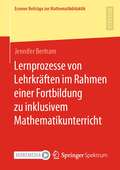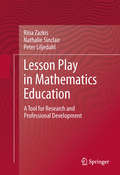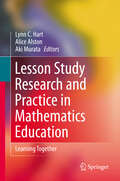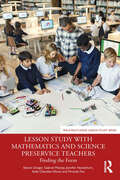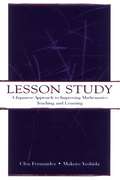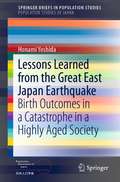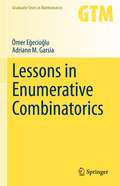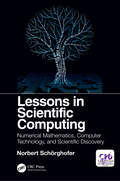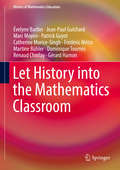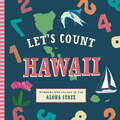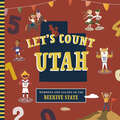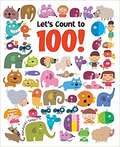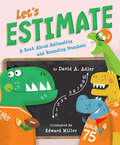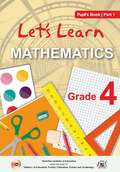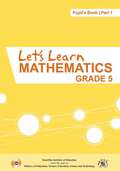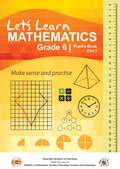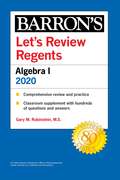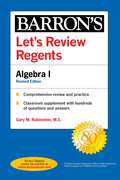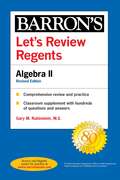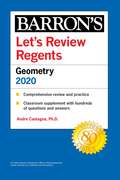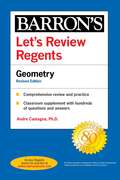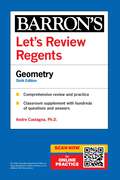- Table View
- List View
Lernprozesse von Lehrkräften im Rahmen einer Fortbildung zu inklusivem Mathematikunterricht (Essener Beiträge zur Mathematikdidaktik)
by Jennifer BertramFür eine effektive und systematische Fortbildungsgestaltung ist das Wissen über typische Lernprozesse von Lehrkräften von besonderer Bedeutung. Bisher gibt es noch keine umfangreichen empirischen Forschungserkenntnisse mit Blick auf die Betrachtung gegenstandsbezogener, d.h. für den konkreten Fortbildungsgegenstand spezifizierter Lernprozesse im Bereich eines inklusiven Mathematikunterrichts. Inklusiver Mathematikunterricht wird dabei verstanden als ein Unterricht, der die Heterogenität aller Schülerinnen und Schüler berücksichtigt und ihnen fachliche Zugänglichkeit sowie soziale Teilhabe ermöglicht. Die vorliegende Arbeit untersucht deswegen gegenstandsbezogene Lernprozesse von Lehrkräften im Rahmen einer Fortbildung zu inklusivem Mathematikunterricht (in der Sekundarstufe I) und geht den zentralen Fragen nach, welche typischen Lernwege der Lehrkräfte identifiziert werden können und inwiefern diese eine Verbindung zum Fortbildungsinhalt aufweisen.
Lesson Play in Mathematics Education:
by Rina Zazkis Nathalie Sinclair Peter LiljedahlLesson play is a novel construct in research and teachers' professional development in mathematics education. Lesson play refers to a lesson or part of a lesson presented in dialogue form--inspired in part by Lakatos's evocative Proofs and Refutations--featuring imagined interactions between a teacher and her/his students. We have been using and refining our use of this tool for a number of years and using it in a variety of situations involving mathematics thinking and learning. The goal of this proposed book is to offer a comprehensive survey of the affordances of the tool, the results of our studies--particularly in the area of pre-service teacher education, and the reasons that the tool offers such productive possibilities for both researchers and teacher educators.
Lesson Study Research and Practice in Mathematics Education
by Alice S. Alston Lynn C. Hart Aki MurataLesson study is a professional development process that teachers engage in to systematically examine their practice, with the goal of becoming more effective. Originating in Japan, lesson study has gained significant momentum in the mathematics education community in recent years. As a process for professional development, lesson study became highly visible when it was proposed as a means of supporting the common practice of promoting better teaching by disseminating documents like standards, benchmarks and nationally validated curricula. While the body of knowledge about lesson study is growing, it remains somewhat elusive and composed of discrete research endeavors. As a new research area there is no coherent knowledge base yet. This book will contribute to the field bringing the work of researchers and practitioners together to create a resource for extant work. This book describes several aspects of Lesson Study, amongst others: it gives an historical overview of the concept, it addresses issues related to learning and teaching mathematics, it looks at the role of the teacher in the process. The last two sections of the book look at how lesson Study can be used with preservice mathematics teachers and at university mathematics methods teaching.
Lesson Study with Mathematics and Science Preservice Teachers: Finding the Form (WALS-Routledge Lesson Study Series)
by Kelly Chandler-Olcott Sharon Dotger Gabriel Matney Jennifer Heckathorn Miranda FoxThis insightful volume offers an overview of the fundamentals of lesson student practice in US teacher education as well as examples from math and science teacher educators using lesson study in their local contexts. The number of teacher educators using lesson study with preservice teachers is small but growing. This book is aimed at teacher educators who may want to try lesson study in university contexts without the challenge of translating the practice from the K-12 context on their own. In this volume, lesson study is broadly overviewed, attention is given to its constituent steps, and examples of lesson study in preservice contexts are shared. Given the broad array of teacher education program designs, numerous contingencies guide teacher educators in their implementation of lesson study, given their contextual affordances and limitations. The lesson study descriptions and cases in this book will support teacher educators and scholars across subject specialities and geographic lines, as they seek instructional frameworks to advance their pedagogical goals.
Lesson Study: A Japanese Approach To Improving Mathematics Teaching and Learning (Studies in Mathematical Thinking and Learning Series)
by Clea Fernandez Makoto YoshidaLesson study is a popular professional development approach in Japan whereby teachers collaborate to study content, instruction, and how students solve problems and reach for understanding in order to improve elementary mathematics instruction and learning in the classroom. This book is the first comprehensive look at the system and process of lesson study in Japan. It describes in detail the process of how teachers conducted lesson study--how they collaborated in order to develop a lesson, what they talked about during the process, and what they looked at in order to understand deeply how students were learning. Readers see the planning of a mathematics lesson, as well as how much content knowledge the teachers have. They observe students' problem solving strategies and learn how Japanese teachers prepare themselves to identify those strategies and facilitate the students' discussion. Written for mathematics teachers, educational researchers, school administrators interested in teachers' professional development, and professional developers, this landmark volume provides an in-depth understanding of lesson study that can lead to positive changes in teachers' professional development and in teaching and learning in the United States.
Lessons Learned from the Great East Japan Earthquake: Birth Outcomes in a Catastrophe in a Highly Aged Society (SpringerBriefs in Population Studies)
by Honami YoshidaThis book provides insights into the enormous impact of fetal and newborn loss in the aftermath of the natural disasters that Japanese society constantly has to face. It first reveals effect of the Great East Japan Earthquake in 2011 on the next generation and reproductive attitudes and shows that prenatal care strategies for emergencies had not been established by any local government in Japan. With continuing research on birth outcomes in the area surrounding the catastrophe, the authors emphasize the importance of the pre-hospital obstetric care team in disaster response and highlight the inequality in health care in a highly aging society like Japan, where perinatal health care is given lower priority than elderly care.Following the creation of a specialized project for pre and postnatal care the authors conducted surveys on how community preparedness in maternal and child health for post-disaster areas impacted population changes.This book is a valuable resource for researchers who are interested in the association between rapid population decline and the disaster management system for maternal and child health, as well as the effect of culture, gender bias, and family traditions.
Lessons in Enumerative Combinatorics (Graduate Texts in Mathematics #290)
by Adriano M. Garsia Ömer EğecioğluThis textbook introduces enumerative combinatorics through the framework of formal languages and bijections. By starting with elementary operations on words and languages, the authors paint an insightful, unified picture for readers entering the field. Numerous concrete examples and illustrative metaphors motivate the theory throughout, while the overall approach illuminates the important connections between discrete mathematics and theoretical computer science. Beginning with the basics of formal languages, the first chapter quickly establishes a common setting for modeling and counting classical combinatorial objects and constructing bijective proofs. From here, topics are modular and offer substantial flexibility when designing a course. Chapters on generating functions and partitions build further fundamental tools for enumeration and include applications such as a combinatorial proof of the Lagrange inversion formula. Connections to linear algebra emerge in chapters studying Cayley trees, determinantal formulas, and the combinatorics that lie behind the classical Cayley–Hamilton theorem. The remaining chapters range across the Inclusion-Exclusion Principle, graph theory and coloring, exponential structures, matching and distinct representatives, with each topic opening many doors to further study. Generous exercise sets complement all chapters, and miscellaneous sections explore additional applications. Lessons in Enumerative Combinatorics captures the authors' distinctive style and flair for introducing newcomers to combinatorics. The conversational yet rigorous presentation suits students in mathematics and computer science at the graduate, or advanced undergraduate level. Knowledge of single-variable calculus and the basics of discrete mathematics is assumed; familiarity with linear algebra will enhance the study of certain chapters.
Lessons in Scientific Computing: Numerical Mathematics, Computer Technology, and Scientific Discovery
by Norbert Schorghofer<p>Taking an interdisciplinary approach, this new book provides a modern introduction to scientific computing, exploring numerical methods, computer technology, and their interconnections, which are treated with the goal of facilitating scientific research across all disciplines. <p>Each chapter provides an insightful lesson and viewpoints from several subject areas are often compounded within a single chapter. Written with an eye on usefulness, longevity, and breadth, Lessons in Scientific Computing will serve as a "one stop shop" for students taking a unified course in scientific computing, or seeking a single cohesive text spanning multiple courses. <p>Features: <p> <li>Provides a unique combination of numerical analysis, computer programming, and computer hardware in a single text <li>Includes essential topics such as numerical methods, approximation theory, parallel computing, algorithms, and examples of computational discoveries in science <li>Written in a clear and engaging style <li>Not wedded to a specific programming language</li> </p>
Let History into the Mathematics Classroom
by Évelyne Barbin Jean-Paul Guichard Marc Moyon Patrick Guyot Catherine Morice-Singh Frédéric Métin Martine Bühler Dominique Tournès Renaud Chorlay Gérard HamonThis book brings together 10 experiments which introduce historical perspectives into mathematics classrooms for 11 to 18-year-olds. The authors suggest that students should not only read ancient texts, but also should construct, draw and manipulate. The different chapters refer to ancient Greek, Indian, Chinese and Arabic mathematics as well as to contemporary mathematics. Students are introduced to well-known mathematicians--such as Gottfried Leibniz and Leonard Euler--as well as to less famous practitioners and engineers. Always, there is the attempt to associate the experiments with their scientific and cultural contexts. One of the main values of history is to show that the notions and concepts we teach were invented to solve problems. The different chapters of this collection all have, as their starting points, historic problems--mathematical or not. These are problems of exchanging and sharing, of dividing figures and volumes as well as engineers' problems, calculations, equations and congruence. The mathematical reasoning which accompanies these actions is illustrated by the use of drawings, folding, graphical constructions and the production of machines.
Let's Count Hawaii
by Trish Madson1 red ukulele plays a tropical tune.2 yellow hibiscus flowers beautifully in bloom.3 brown coconuts hang on a palm tree.4 blue marlin swim deep in the sea.Numbers and colors are more fun in Hawaii! In this dynamic, colorful primer, young readers count from 1 to 10, learning about colors along the way as they discover the places, animals, and other wonderful things that make Hawaii so unique!
Let's Count Utah
by Christopher RobbinsNumbers and colors are more fun in Utah! In this dynamic, colorful primer, young readers count from 1 to 10 as they discover the places, animals, and other wonderful things that make Utah so unique.
Let's Estimate: A Book About Estimating and Rounding Numbers
by David A. AdlerPartying dinos explain estimation in this entertaining introduction by a tried-and-true team of fun math book creators. How much pizza do you need for a dinosaur party? If you don't know exactly, you have to estimate! This lively introduction to the mathematical concept of estimation is straightforward and fun. With brilliant clarity, David A. Adler explains what an estimate is and the difference between estimating and rounding. Edward Miller's colorful and energetic artwork offers the perfect accompaniment to concise, engaging text. Filled with graspable examples and simple explanations, Let's Estimate will have kids estimating like pros!
Let's Learn Mathematics Part-1 - Pupil's Book class 4 - MIE
by Mauritius Institute of EducationThe Mathematics Grade 4 Pupil's Book Part 1 for Mauritius encompasses a comprehensive curriculum divided into eight units. It begins with foundational skills in numeration, addition, subtraction, multiplication, and division, progressing to more advanced concepts like patterns, even and odd numbers, and fractions. The foreword and preface introduce the book's objectives, layout, and contributors, while the table of contents aids navigation. Learning objectives emphasize key skills pupils should master, including numerical operations and problem-solving. Each unit features subtopics, examples, exercises, activities, an IT corner, and continuous assessment. From numeration and notation to fractions, the textbook systematically guides students through the mathematical landscape. A final revision sheet consolidates learning, offering a thorough review with diverse question types and answers, ensuring a holistic grasp of Grade 4 mathematics.
Let's Learn Mathematics Part-1 - Pupil's Book class 5 - MIE
by Mauritius Institute of EducationThe "MATHEMATICS Grade 5 Pupil’s Book Part 1" is a comprehensive textbook crafted by a panel of mathematics experts from the Mauritius Institute of Education and the Ministry of Education and Human Resources, Tertiary Education and Scientific Research. Designed for Grade 5 students in Mauritius, the book covers essential aspects of the mathematics curriculum, including numeration, notation, geometry, fractions, and powers. With a vibrant and visually appealing layout, the book features clear learning objectives, engaging activities, illustrative examples, and diverse exercises for practice. Aligned with the national curriculum framework, it incorporates continuous assessments to gauge understanding. The book employs a friendly tone to inspire students, providing encouragement, tips, and hints, and includes questions, puzzles, and games to foster curiosity. Intended for students, teachers, and parents, this resource aims to cultivate mathematical proficiency, skills, confidence, appreciation, and interest in young learners.
Let's Learn Mathematics Part-1 - Pupil's Book class 6 - MIE
by Mauritius Institute of EducationGrade 6 part 1 mathematics textbook follows the National Curriculum Framework, encompassing units on shapes, numeration, fractions, decimals, and problem-solving techniques. The curriculum introduces students to 2-D and 3-D shapes, emphasizing properties, classification, and drawing techniques. Numeration and place value cover reading and writing large numbers, using tools like arrays and abacus. The text explores division with remainders, methods for comparing quantities, and the concepts of fractions and decimals, detailing addition, subtraction, multiplication, and division operations. Problem-solving strategies like thinking blocks and drawing diagrams are introduced with examples spanning various real-world scenarios. The book includes continuous assessments and challenging problems across multiple mathematical domains, fostering problem-solving skills. Motivational quotes from mathematicians and scientists aim to inspire students, while thorough references provide additional resources. Answers are provided with explanations, utilizing LaTeX for mathematical expressions. This comprehensive textbook aims to engage and empower Grade 6 pupils in their mathematical learning journey.
Let's Learn Mathematics Part-2 - Pupil's Book class 4 - MIE
by Mauritius Institute of EducationThe grade 4 mathematics textbook, part 2 of a series, delves into fundamental mathematical concepts with a focus on practical applications for fourth-grade pupils. Covering lines, angles, 2-D and 3-D shapes, time, length, capacity, mass, and graphs, the curriculum emphasizes hands-on learning. Students learn to draw and compare lines, create and measure angles using an angle maker, and explore the properties of 2-D and 3-D shapes. The textbook introduces time-telling skills using analog and digital clocks, and addresses the measurement of length, capacity, and mass with real-world examples. Additionally, it provides a foundation for data interpretation through the representation and analysis of graphs using pictograms and bar charts. This comprehensive approach aims to foster a holistic understanding of mathematical principles while promoting practical problem-solving skills.
Let's Learn Mathematics Part-2 - Pupil's Book class 5 - MIE
by Mauritius Institute of EducationThis grade 5 mathematics textbook comprises four comprehensive units designed to enhance pupils' mathematical proficiency. Unit 1, "Numbers," delves into concepts such as average, direct proportion, ratio, and fractions, offering clear definitions, examples, and engaging activities. Unit 2, "Measure," explores diverse measurement topics, including length, perimeter, area, capacity, mass, money, and time, emphasizing practical applications through exercises and word problems. Unit 3, "Graphs," focuses on pictograms and bar charts, guiding pupils in interpreting and utilizing graphs for data representation. The final unit, "Continuous Assessment," evaluates students through multiple-choice and short-answer questions, ensuring a thorough understanding of the material. Throughout the textbook, each unit features valuable tips and hints to facilitate comprehension and practical application of mathematical principles.
Let's Learn Mathematics Part-2 - Pupil's Book class 6 - MIE
by Mauritius Institute of EducationThe textbook, "MATHEMATICS Grade 6 Pupil’s Book Part 2," authored by Professor Vassen NAËCK and a team of mathematics experts from the Mauritius Institute of Education and the Ministry of Education, serves as a comprehensive guide for sixth-grade students. Covering essential mathematical concepts, it spans topics such as numbers, measure, geometry, charts, and problem-solving. Highlighting key units, the textbook explores Patterns and Sequences (Unit 16), Powers (Unit 17), and Time - Calendar (Unit 18). These units provide in-depth explanations, examples, and exercises, offering students a thorough understanding of mathematical principles. The textbook's well-structured content, consisting of units with diverse subtopics, ensures a comprehensive approach to sixth-grade mathematics education. Furthermore, the appendices provide practical templates for constructing 3-D cubes and cuboids, enhancing the hands-on learning experience. Overall, the textbook serves as a valuable resource, fostering a holistic and engaging learning environment for students.
Let's Review Regents: Algebra I 2020 (Barron's Regents NY)
by Gary M. RubinsteinBarron's Let's Review Regents: Algebra I 2020 gives students the step-by-step review and practice they need to prepare for the Regents exam. This updated edition is an ideal companion to high school textbooks and covers all Algebra I topics prescribed by the New York State Board of Regents. Features include: * In-depth Regents exam preparation, including two recent Algebra I Regents exams and answer keys * Easy to read topic summaries * Step-by-step demonstrations and examples * Review of all Algebra I topics * Hundreds of sample questions with fully explained answers for practice and review, and more Teachers can also use this book to plan lessons and as a helpful resource for practice, homework, and test questions. Looking for additional review? Check out Barron’s Regents Algebra I Power Pack 2020 two-volume set, which includes Regents Exams and Answers: Algebra I 2020 in addition to Let’s Review Regents: Algebra I 2020.
Let's Review Regents: Algebra I Revised Edition (Barron's Regents NY)
by Gary M. RubinsteinBarron's Let's Review Regents: Algebra I 2020 gives students the step-by-step review and practice they need to prepare for the Regents exam. This updated edition is an ideal companion to high school textbooks and covers all Algebra I topics prescribed by the New York State Board of Regents. All Regents test dates for 2020 have been canceled. Currently the State Education Department of New York has released tentative test dates for the 2021 Regents. The dates are set for January 26-29, 2021, June 15-25, 2021, and August 12-13th. Features include:In-depth Regents exam preparation, including two recent Algebra I Regents exams and answer keysEasy to read topic summariesStep-by-step demonstrations and examplesReview of all Algebra I topicsHundreds of sample questions with fully explained answers for practice and review, and moreTeachers can also use this book to plan lessons and as a helpful resource for practice, homework, and test questions.Looking for additional review? Check out Barron&’s Regents Algebra I Power Pack 2020 two-volume set, which includes Regents Exams and Answers: Algebra I 2020 in addition to Let&’s Review Regents: Algebra I 2020.
Let's Review Regents: Algebra II Revised Edition (Barron's Regents NY)
by Gary M. Rubenstein M.S.Barron's Let's Review Regents: Algebra II 2020 gives students the step-by-step review and practice they need to prepare for the Regents exam. This updated edition is an ideal companion to high school textbooks and covers all Algebra II topics prescribed by the New York State Board of Regents. All Regents test dates for 2020 have been canceled. Currently the State Education Department of New York has released tentative test dates for the 2021 Regents. The dates are set for January 26-29, 2021, June 15-25, 2021, and August 12-13th. Features include:In-depth Regents exam preparation, including two recent Algebra II Regents exams and answer keysEasy to read topic summariesStep-by-step demonstrations and examplesHundreds of sample questions with fully explained answers for practice and review, and moreReview of all Algebra II topics, including Polynomial Functions, Exponents and Equations, Transformation of Functions, Trigonometric Functions and their Graphs, Using Sine and Cosine, and much moreTeachers can also use this book to plan lessons and as a helpful resource for practice, homework, and test questions.Looking for additional practice and review? Check out Barron&’s Algebra II Power Pack 2020 two-volume set, which includes Regents Exams and Answers: Algebra II 2020 in addition to Let&’s Review Regents: Algebra II 2020.
Let's Review Regents: Geometry 2020 (Barron's Regents)
by Andre CastagnaBarron's Let's Review Regents: Geometry 2020 gives students the step-by-step review and practice they need to prepare for the Regents exam. This updated edition is an ideal companion to high school textbooks and covers all Geometry topics prescribed by the New York State Board of Regents.This edition includes: Two actual Regents exams in Geometry, plus answer keys for each test. Review and practice problems for all topics on the exam, including the language of geometry, basic geometric relationships (parallel lines, polygons, and triangle relationships), constructions, an introduction to geometric proof transformations, triangle congruence, similarity and right triangle trigonometry, parallelograms, circles and arcs, coordinate geometry and proofs on the coordinate plane, and volume (modeling 3-D shapes in practice applications) Looking for additional review? Check out Barron’s Regents Geometry Power Pack 2020 two-volume set, which includes Regents Exams and Answers: Geometry 2020 in addition to Let’s Review Regents: Geometry 2020.
Let's Review Regents: Geometry Revised Edition (Barron's Regents NY)
by Andre Castagna Ph.D.Barron's Let's Review Regents: Geometry 2020 gives students the step-by-step review and practice they need to prepare for the Regents exam. This updated edition is an ideal companion to high school textbooks and covers all Geometry topics prescribed by the New York State Board of Regents.All Regents test dates for 2020 have been canceled. Currently the State Education Department of New York has released tentative test dates for the 2021 Regents. The dates are set for January 26-29, 2021, June 15-25, 2021, and August 12-13th. This edition includes:Two actual Regents exams in Geometry, plus answer keys for each testReview and practice problems for all topics on the exam, including the language of geometry, basic geometric relationships (parallel lines, polygons, and triangle relationships), constructions, an introduction to geometric proof transformations, triangle congruence, similarity and right triangle trigonometry, parallelograms, circles and arcs, coordinate geometry and proofs on the coordinate plane, and volume (modeling 3-D shapes in practice applications)Looking for additional review? Check out Barron&’s Regents Geometry Power Pack 2020 two-volume set, which includes Regents Exams and Answers: Geometry 2020 in addition to Let&’s Review Regents: Geometry 2020.
Let's Review Regents: Geometry, Sixth Edition (Barron's New York Regents)
by Barron's Educational Series Andre, Ph.D. Castagna Ph.D.Barron's Let's Review Regents: Geometry gives students the step-by-step review and practice they need to prepare for the Regents exam. This updated edition is an ideal companion to high school textbooks and covers all Geometry topics prescribed by the New York State Board of Regents. Features include: In-depth Regents exam preparation, including one recent Geometry Regents exam and a sample of the revised test for the changes being made for 2025, both with full answer keys Review of all Geometry topics as per the revised course and exam for 2025 Easy to read topic summaries Revised step-by-step demonstrations and examples Hundreds of questions with fully explained answers for extra practice and review, and more Publisher's Note: Products purchased from 3rd party sellers are not guaranteed by the publisher for quality, authenticity, or access to any online entities included with the product.
